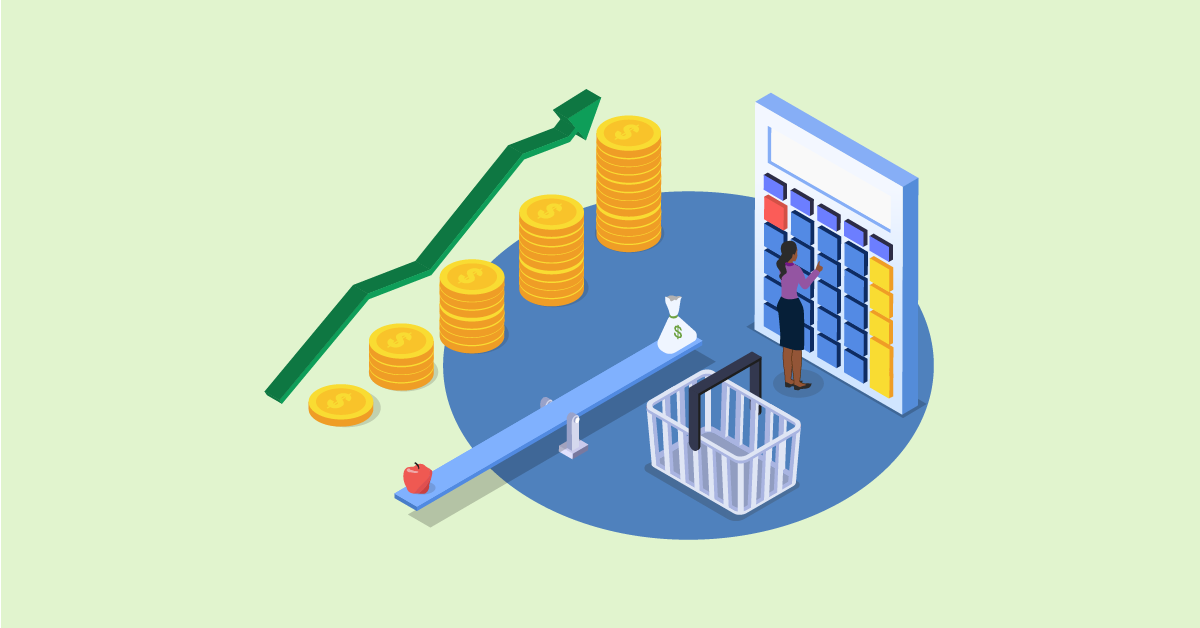
Inflation: Roadblock or Opportunity?
You’ve probably noticed you’re paying more to buy groceries, fill up at the gas station, and buy other household items. The culprit? Inflation. It’s been a big topic of focus in the political and financial landscape in recent months. It may have you wondering: what is inflation, what causes it, and what are some strategies to help keep you on your financial journey?
Simply stated, inflation is the general rise of average prices across the country. The U.S. government measures inflation using two metrics—the Consumer Price Index (CPI) and the Producer Price Index (PPI). Let’s take a quick look at both metrics to get a better understanding of what’s happening today.
What is Inflation?
The CPI measures changes in the price level of goods and services across the country. The Bureau of Labor Statistics maintains a basket of goods and services most commonly used by the average household such as bread, milk, gasoline, housing costs, etc. They track price changes in this basket over time. If the overall price of the basket goes up 3%, we say that inflation is 3%.
The PPI measures the average changes in the selling prices received by domestic producers. If American companies charge more for their products or services, the PPI measures this increase as inflation.
The PPI differs from the CPI in terms of the goods and services covered, the types of prices collected, and the extent of coverage of the services sector.
What Causes Inflation?
Many factors can cause inflation, including increased money supply, demand for goods without increased supply, and wages and material costs.
The Federal Reserve controls money supply and can raise or lower interest rates and change the amount of money banks are able to lend to customers. When interest rates are low and banks are able to lend more money, it’s a sign of an expansionary monetary policy. Because it’s easier and cheaper to get a loan when interest rates are low, individuals are more likely to borrow money to buy a new car or remodel their kitchens. Businesses may also hire more workers or expand. This economic activity creates increased demand, which, in turn causes higher costs.
The supply and demand relationship is also a contributing factor to inflation. We’re seeing the impacts of this supply and demand relationship at play with the current disruptions in the supply chain. A timely example of this effect occurred with gas prices during the Coronavirus pandemic. When many businesses and travel first shut down, the demand for oil decreased dramatically because fewer people were driving. Because there was an abundance of oil supply and a lack of demand, the price of oil fell. As more people began driving again, the opposite occurred. Demand for oil outpaced the supply, contributing to higher prices at the gas pumps. Another example is that despite an increase in demand for certain consumer goods, such as computer chips, supply is lagging which is also contributing to inflation.
The last common cause of inflation is an increase in the cost of wages or materials. When wages and material costs go up, a company generally will either lower its profit margin or, more commonly, increase prices to pass costs on to customers. If you recently built or remodeled a home, you may recall paying more because of a shortage of lumber. Homebuilders paid more for materials because higher costs were passed on to the customer.
How Can I Protect my Finances During Inflation?
Now that you understand more about inflation, let’s look at some strategies to help keep you on a secure path financially. As always, you should consult with your financial advisor prior to making any changes to your investment strategy.
- Avoid purchasing inflated goods, if possible. While you may not be able to avoid the necessities like food or utilities, you may want to postpone buying non-essential goods. For example, because of a new-car shortage, the price of used cars has gone up. If you can wait for the car shortage to correct and avoid buying a car now, it may help avoid consequences of inflation.
- Avoid high cash holdings. While cash savings and an emergency fund are an important part of a sound financial plan, having too much cash during high inflation can hurt. For example, if you have $10,000 in cash earning no interest, and inflation for the year is 5%, your $10,000 is effectively worth 5% less, or $9,500. Investing your cash in a high-yield savings account can help mitigate some of the losses due to inflation.
- Explore Growth Company investments. These companies focus on investing much of their profits to grow the company. They tend to do well during periods of high inflation because money is easily accessible, allowing them to borrow and invest.
- Explore commodity or real estate investments. Intuitively it makes sense that these investments tend to do well during times of high inflation. Since inflation measures the rise in prices of goods and services, investments that include those goods and services—like commodities and real estate– will likely rise as well.
- Look into Treasury Inflation Protected Securities (TIPS). TIPS are an investment that track inflation and pay interest based on changes in inflation. These interest payments have a fixed rate that is determined twice each year and based on inflation and deflation.
- Continue contributing to your retirement and health savings accounts. Inflation is inevitable; but by continuing to prepare for future financial needs, you’ll have a slight edge over future inflationary adjustments.
By learning more about inflation and how it impacts your day-to-day and long-term finances, you may see that it can be both a roadblock and opportunity. Stay up to date on financial topics by downloading the BPAS University app.
* The information provided is for general information only and should not be construed as advice. Please consult with your financial advisor in regards to your own account.
Joe McCabe is a Participant Education Specialist with BPAS Fiduciary Services.

